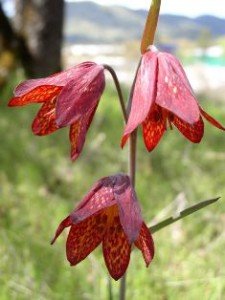
Fritillaria gentneri, photo by US Fish and Wildlife
Edit March 11, 2016: The Jordan Cove LNG terminal project has been rejected by the Federal Energy Regulatory Commission!
This beautiful flower is an endangered species called the “Gentner’s Fritillary”. It lives here in Oregon and is one of four endangered species that will be “adversely affected by the pipeline” according to the Federal Energy Regulatory Commission. There are currently only 1,200 plants in existence.
The “pipeline” is the Liquified Natural Gas (LNG) 36″ wide, 232 mile pipe that will transport Canadian and Rocky Mountain LNG (from fracking) across Oregon and to a port in Coos Bay for exportation. The pipeline is scheduled to go under two major rivers (the Klamath and the Rogue)!
Construction of the pipeline would impact approximately 4,523 acres of vegetation. This would consist of 2,882 acres of forested lands, 643 acres of grasslands/shrublands, 103 acres of wetland/riparian areas, and 896 acres of agricultural areas. Of the forested land crossed, about 821 acres of late-successional old-growth, 821 acres of mid-seral, and 1,240 acres of clear-cut or regenerating forests would be impacted. (FERC report)
The “Pacific Connector” is require to develop a “Federally-Listed Plant Conservation Plan” to address the 4 critically endangered species that it could potentially eliminate. I have been unable to find the Conservation Plan. If anyone knows anything about this plan please let me know. My assumption is that they are still trying to create one. Let’s make sure it actually happens!
See a map of the proposed pipeline according to the Pacific Connector website: http://pacificconnectorgp.com/maps/
